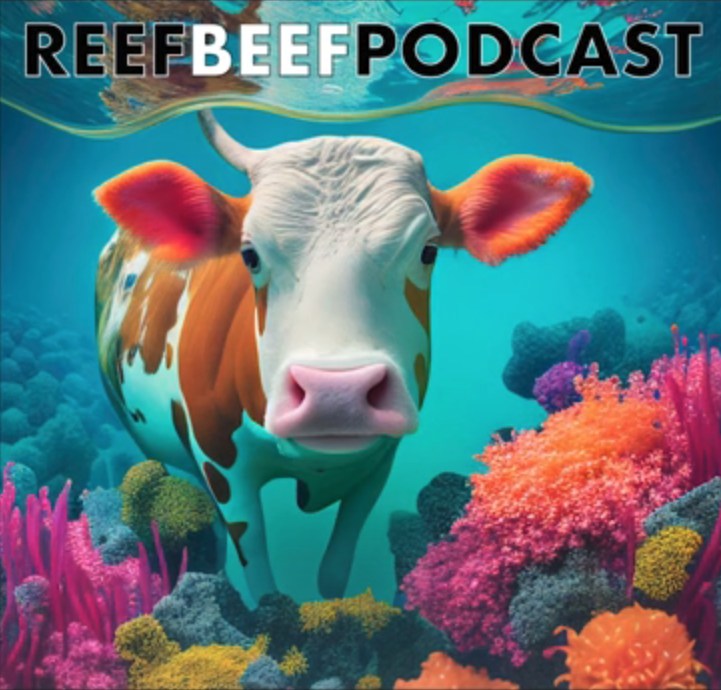By Rich Ross
From ReefsMagazine
Swimming through a coral spawn is a peak experience if you are a coral nut like me. I know some find the idea swimming through clouds of coral sperm and eggs to be super icky, but to me, it’s a dream come true. I have been watching film of this phenomenon since I was a wide-eyed little kid, wishing I would get the chance to see it first hand, but figured it would never happen. I was wrong. I experienced coral sex in the wild for the first time while in the field in the Philippines collecting corals for the Steinhart Aquarium in the California Academy of Sciences. I will never forget swimming along in the dark with Matt Wandell and Bart Shepherd, seeing some stuff in the water, the three of us realizing what was happening, and then screaming at each other under water. A peak experience for sure for that wide-eyed little kid. Since then, I have been fortunate to work on coral sexual reproduction in a more rigorous way through the my work, and an ongoing program run by the Florida Aquarium, Conservation Of Reef Life, or CORL.
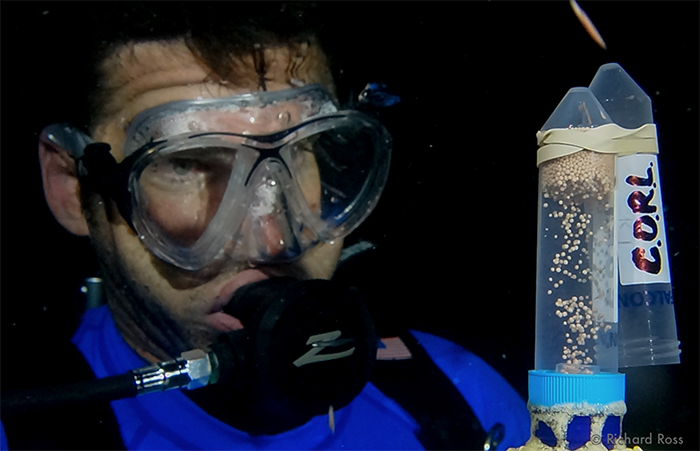
For the past 8 years aquarium biologists from multiple institutions have been trekking to Tavernier in the Florida Keys every August to work on the sexual reproduction and restoration of the endangered Staghorn coral, Acropora cervicornis. This years event was filled with worry, excitement, boredom and joy – the best fieldwork is like that, and below, I will go into detail about each emotion. The program was started after Ryan Czaja of the Florida Aquarium attended a SECORE workshop (SExual COral REproduction – a fantastic organization). Ryan brought what he learned back to Florida, and partnered with the Coral Restoration Foundation to do a Florida based workshop. When the program started it consisted of just a few people doing all the work which was incredibly fun, exciting and exhausting. This year the project grew to just under 50 people from 15 different organizations (including Seaworld and the Georgia Aquarium) doing everything from collection, fertilization trials, development trials, settlement trials to cryo preservation of coral sperm.
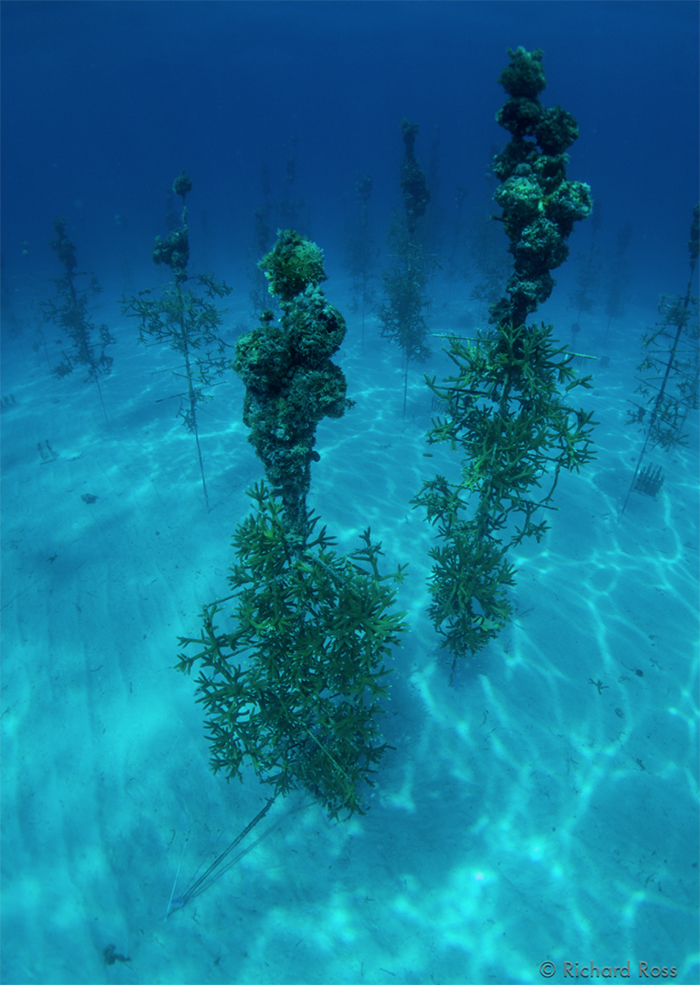
Staghorn Coral Sex in a Nutshell Staghorn coral produces egg & sperm bundles which are ejected from the corals polyps en mass (some other corals, like the Pillar corals, Dendrogyra cylindricus, produce sperm and eggs separately). It is thought that the sperm and egg from the same genotype of Staghorn coral cannot self fertilize. The egg and sperm bundles float to the surface where they break up and mix with the sperm and eggs of other colonies resulting in all kinds of genetic diversity. The fertilized embryos float around for a few days, developing though different stages, until they transform into a planulae, a swimming baby coral. Yes, baby corals swim around till they find a nice place to settle down until the colony is large enough to spawn on its own. The world is amazing right? So, why isn’t this working in the keys like it is supposed to? We aren’t quite sure. Could be that now a days there just aren’t enough corals of different genotypes close enough to each other to cross-fertilize. Could be that environmental conditions are bad enough that fertilization doesn’t occur or development is poor or settlement is impossible due to undeniable human impacts on the reefs (sewage and a million boats as well as general climate change). Could be a mix of reasons. For whatever reason it isn’t working in nature, it isn’t, so people got involved to understand what is happening, and help it happen better.
https://vimeo.com/179650430
Working with the Spawn in a Nutshell To collect the spawn, an hour or so before sunset, tent nets with a collection chambers are set up over corals that are likely to spawn. When the corals spawn, the sperm and egg bundles float up inside the tent and into the collection chamber. Once the collection chamber is full, it is removed from the tent, capped, and taken up to the boat where processing starts while the boat rushes back towards the lab. The sperm and egg bundles start to separate, and the sperm and eggs are placed into separate containers where they can be combined in different proportions to better shepherd fertilization as well as to create specific genetic crosses of particular corals. Eggs are counted. Sperm is counted. Eggs and sperm are mixed. Sperm is frozen. Fertilized embryos are then moved to development tanks and the 24-hour a day monitoring moves into high gear. Do they have enough water motion, but not too much? Is the temperature just right? Is the water quality still high? Are the developing corals clumping together too much, and if so how often do you separate them? Are they developing? Are they swimming yet? Once the baby corals start swimming, they are packed up and sent to different institutions for settlement and grow out – both developmental hurdles that we are trying to better understand. As you can see, fertilization and development is a very labor-intensive process. Why the Keys? By many estimates, hard coral coverage in the Florida Keys has been reduced by over 90% since the 1970’s (some estimate 98%). That is a staggering figure, so let it wash over you for a minute. More icky than swimming through corals sperm and eggs right?

Today’s reefs in the Keys look nothing like they looked a few decades ago. Gone are the massive stands of reef building Staghorn and Elkhorn Coral (Acropora palmata) that were an important part of the ecosystem, providing habitat for all kinds of animals. Now the reefs are primarily made up of sea fans and algae. The Coral Restoration Foundation (CRF) was established to help restore Staghorn Coral to the area (though now they work with multiple species all over the Caribbean) by asexually propagation. Corals are cut into fragments in an offshore nursery, placed on sunken artificial ‘trees’ to maximize growth, and then planted back onto natural reefs. The CRF is doing great work, planting thousands of corals from the offshore nursery back into the wild (please never release anything from your home aquarium into the wild – so many possibilities for invasive species and disease introduction). Asexual reproduction is great, but it is a slow process that produces a limited number of new corals that are often all of the same genotype, meaning genetic diversity on the replanted reefs can remain low. Sexual coral reproduction, on the other hand, can quickly produce millions of tiny genetically diverse corals – with the one catch…we aren’t yet great at doing it on a mass scale. We are learning, which is part of the point of projects like CORL and SECORE. Partnering with the Coral Restoration Foundation in the Florida Keys makes great sense because the corals on the ‘trees’ at the nursery have known genotypes. This means we can track lineage over time to determine which crosses have which particular characteristics – do some grow faster? Settle quicker? More tolerant to heat or CO2? Partnering with the Coral Restoration Foundation gives us even more; The nursery is easy to dive even in iffy weather, all the genotypes are in one place instead of scattered over wild reefs, and corals that appear ready to spawn can be moved to mini ‘trees’ that are easier to set up to collect the spawn from than from wild colonies. The Coral Restoration Foundation also has a wet lab that we can use during the spawn to fertilize the coral eggs and let the embryos develop, as well as a place to bring colonies from the nursery to spawn on land as a hedge against bad weather cancelling dives.
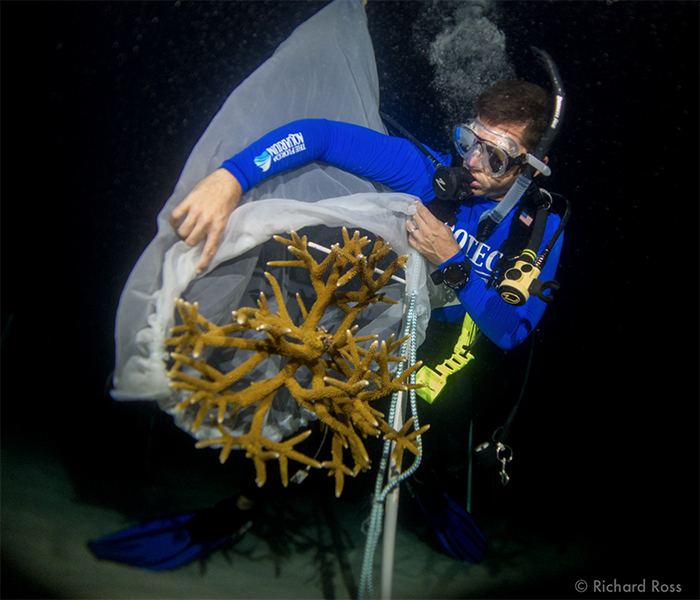
The Worry There is a lot to worry about on a trip like this because lots of people and lots of institutions have dedicated lots of resources to the event. Weather, flights, staffing, building the lab on time, boat problems are all common worries for working trips like the coral spawn. The possibility of missing the spawn completely reared its ugly head. The Staghorn corals generally fire off like clockwork the fourth day after the full moon – one big spawn followed by a slightly smaller spawn, with trickle spawns on either side. The night after the full moon, we got reports from Mexico and Curacao that they had spawn, while in Florida we were not even scheduled to do a spawn dive for two more nights. The fear that the corals were going to go big before we were even ready made us all nervous. We sent a team out to the nursery that night to see what was happening, and observed one genotype spawning that night, but a lot of it, which made us all worry. Did we miss the big spawn? Did we see just a trickle? Is the trip a waste? That diveless night was excruciating. The next night the nets were deployed before sunset, and then we waited, worrying, on the boats for 10 pm to come around, and then hit the water. In minutes it was clear that the corals were ‘setting’, preparing to spawn by moving the eggs up towards the polyp mouths, and were setting big. All our worry was forgotten after two days of excellent spawning.
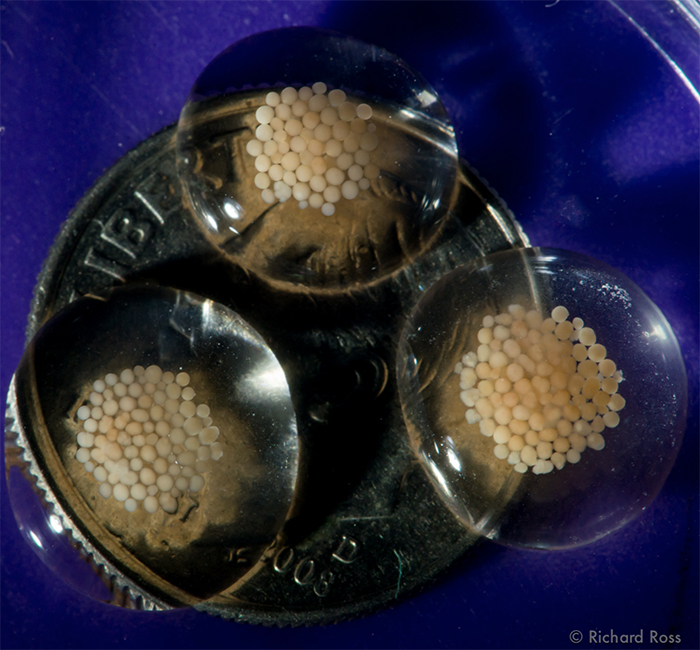
The Excitement Besides the excitement of the whole point of the project panning out, there are two other stand out moments that occurred on the same dive. We took the visiting Cuban Aquarists out to see the Pillar coral spawning, something I had never seen. It was astonishing. The sperm is ejected from the coral first, and is evidenced by the water around the coral becoming hazy. You can see even see clumps of sperm popping out of the coral. This was exciting, but the ejection of the eggs in this coral was simply spectacular. The coral gets all fluffy, with all the tissue filled up and puffed up. Then in one singular squeeze, the eggs are pushed out like some kind of aquatic fireworks. Check out the video to see what I am talking about. Just amazing.

The other exciting moment on that dive was while we were looking for the Pillar corals on the site. We had been looking for them for about 40 minutes, when I heard the Cubans making excited noises. Really excited. I started swimming towards them, looking down to see where the corals were. I saw no corals, but they were still making excited noises, so I looked up and saw them pointing… pointing up above the reef… pointing at a Great Hammerhead shark that was at least 12 feet long. Yes exciting. Yes, no pictures… sometimes you have to just enjoy the moment. And, yes it happened even though there aren’t pictures. The Boredom After the spawn has been collected and everything has been fertilized, we still have to do round the clock checks in the lab to make fine tweaks, track coral development, and head off any problems before they become problems. When your water is collected and delivered by boat and truck, a small leak or over aggressive skimmer can quickly become a real problem. So, someone needs to check the lab every few hours. After a long few days of prepping, diving, collecting, setting stuff up, and getting to bed around midnight, I found myself scheduled to do the 4 am lab check. I knew it was going to be awful and boring and a drag, but hey, I could be at a desk right? I decided I shouldn’t be the only one to see what is going on at 4am, so I threatened to do a Facebook live. I think this is funny because there is no way anyone is going to watch right? Did I mention 4 am? I woke up, got to the lab, and even remembered to do the Facebook live. I had no idea what I was saying on the video, I was just babbling about 4 am for a while as I did checks when I happened to glance at my phone screen and see people asking questions about what was going on, so I had to start being cogent and explaining things. Great idea right, 4 am Facebook live from the lab. Apparently people liked it. Apparently it is still up on my Facebook page. I haven’t watched it. I’ve lived it.
https://vimeo.com/180242168
The Joy There is a lot of joy in this project. We get to be helpful in something that might really matter in the bigger picture. We get to work with colleagues we have known for years and colleagues we have just met. We get to make decisions that impact the project. We get to see the coral spawn, one of the coolest happenings on the planet. We get to trial different ways of doing the work so that next year it will be easier and more productive. We get to do sperm counts and look on as sperm samples are put into liquid nitrogen. We get to science! But, the most joyful thing about this event is the last day, the day when we pack up swimming coral babies to ship out for settlement work.

The last year has been spent planning, we even had a big face-to-face meeting in Tampa, FL in March. We spent the last 12 days setting up a house of cards that could topple at any instant from any one thing going wrong. But on that last day, examining swimming coral babies under the microscope, doing the counts to determine how many we have and how many to put in the shipping bottles, and then finally filling up the bottles so they are like some kind of living lava lamp, all there nothing but joy. So There There you go, a crash course in coral sexual reproduction and a look into what actually happens in the field during this project. So far, it seems we are all pretty happy with the results. We trialed 4 different larval rearing approaches, and it certainly seems like we have found our winner for the future. We have a documented range of sperm density needed for fertilization. We established a much more efficient way of collecting the spawn samples under water and getting them to the lab fast. All in all, we had something like 180,000 swimming baby corals at ship out, and we are primed to do it all even better next year. Hopefully soon, we will be able to add to the Coral Restoration Foundations efforts at out planting corals grown in their nursery, with bagillions of sexually produced corals. If we can all keep this up while we all continue to clean up the habitat of the Florida Keys, perhaps we will all get to swim in new stands of coral in the Florida Keys, stands of coral that rival what was there in the past. It is a good hope that would make the wide-eyed little kid I used to be very proud.
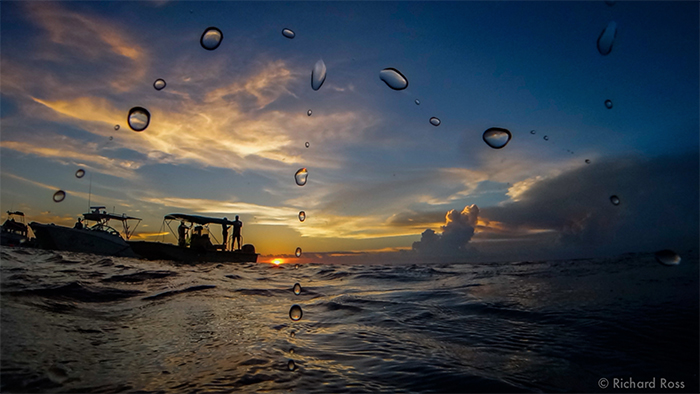
Thanks to Justinn Zimmerman, Kim Stone, Scott Graves, Steve Hartter, Casey Coy, Lauren DeLuca, Scott Graves, Shawn Gardner, Linda Penfold, Cayman Adams, Rick
Klobuchar and everyone else that participated in the CORL spawn. Special thanks to Ben Johnson for his proff reading skills – any mistakes in this article are his fault.
